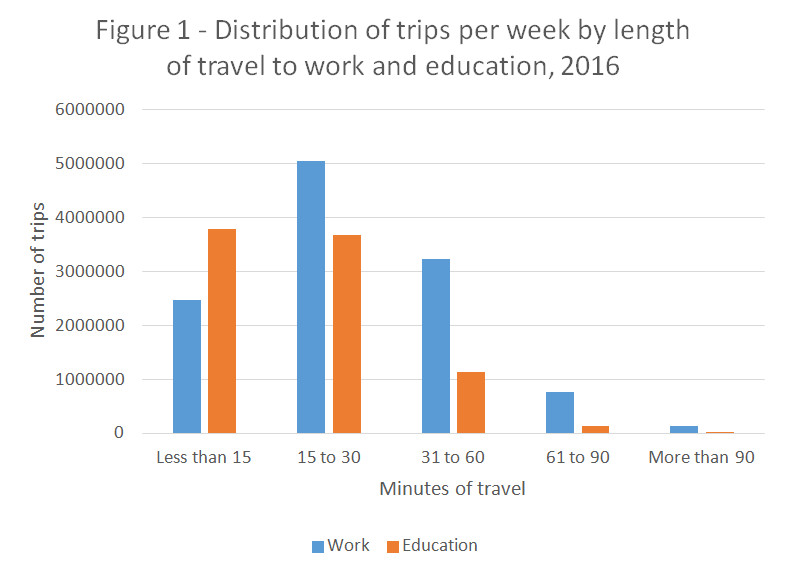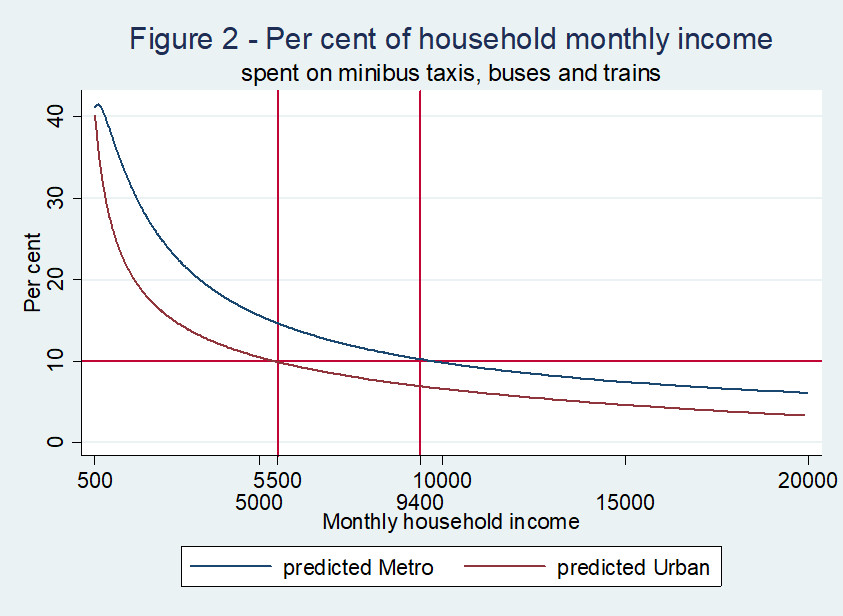
The third, fourth and fifth briefs will deal with trains, buses and minibus taxis and the final brief will discuss the planned future of the transport system in the five largest metros.
Introduction
Travel in South Africa’s metropolitan and urban areas has been shaped by two related factors: a history of racial segregation and relatively low population densities in former white group areas. Inefficient cities have resulted in inefficient patterns of transport. Two developments make current conditions different from those of forty years ago: the end of legally compelled segregation and the rise of the minibus taxi business. Yet de facto residential segregation remains pervasive, cities have made little of the substantial investment necessary to improve public transport, and congestion on often deteriorating roads has risen as the number of cars on them has increased.
This brief and the next seek to present key information from two sources: the 2016 General Household Survey and the 2013 National Household Travel Survey. The second, specialist survey has more detail, but information in it covers only weekdays (Monday to Friday), and its complicated structure has resulted in information which, in some respects, is seriously incomplete. Nonetheless, the two sources together yield useful base line information on the ‘modal split’ (the distribution of travel by mode of transport), the length of travelling times, the cost of travel and the influence of household income on travel patterns.
Data
The General Household Survey asked the following questions:
At the personal level
For work and education separately:
At the household level
For minibus/sedan taxis, buses and trained separately and for the preceding week:
- Trips taken.
- Money paid.
- Distance from home to transport.
The GHS data are based on the place of residence of households and they do not permit a distinction between travel within the relevant metro and urban area and travel outside it.
The modal split and time taken to work and educational institution
Travel to work
Table 1 sets out the modal split for trips to work and their average duration in minutes. Nearly 10% of working people in metros work at home and have no need to travel. They would have to be excluded if travellers only were to be considered.
|
Table 1 - Modal split and average time to work, 2016 |
||||
|
Metro |
Urban |
|||
|
Per cent |
Average time |
Per cent |
Average time |
|
|
Office is at home |
9,7% |
9,6% |
||
|
Walking |
10,2% |
24 |
25,6% |
24 |
|
Bicycle/motorcycle |
0,9% |
32 |
1,2% |
30 |
|
Minibus taxi/sedan taxi/bakkie |
28,2% |
37 |
19,7% |
27 |
|
Bus |
4,2% |
45 |
2,6% |
35 |
|
Train |
5,6% |
47 |
0,5% |
51 |
|
Lift club by a group of people sharing a private vehicle |
2,5% |
35 |
2,8% |
31 |
|
Own car/other private vehicle/company vehicle |
38,7% |
31 |
38,0% |
24 |
|
Total |
100,0% |
35 |
100,0% |
25 |
In both metro and urban areas, the use of own car or other private vehicle or a company vehicle accounts for nearly 40% of trips to work. Second comes minibus taxis, sedan taxis and bakkies in metros, and walking in urban areas. Third comes walking in metros, and minibus taxis, sedan taxis and bakkies in urban areas. The use of buses, trains, bicycles and motorcycles and lift clubs are less often used, collectively accounting for 13% of trips to work in metro areas and 7% in urban areas.
The average times of travel are generally shorter in urban areas than in the metros, not surprisingly given their smaller extent. Travel by bus and train is, on average, longer than travel by minibus taxi, lift club and own car. Average walking time is low, suggesting that most people walk because their work is nearby.
Travel to educational institution
Table 2 sets out the modal split for trips to educational institutions and their average duration in minutes.
|
Table 2 - Modal split and average time to educational institution, 2016 |
||||
|
Metro |
Urban |
|||
|
Per cent |
Average time |
Per cent |
Average time |
|
|
Walking |
48,1% |
29 |
65,6% |
17 |
|
Bicycle/motorcycle |
0,7% |
20 |
0,6% |
20 |
|
Minibus taxi/sedan taxi/bakkie taxi |
9,7% |
41 |
8,1% |
28 |
|
Bus |
3,8% |
37 |
3,1% |
29 |
|
Train |
1,7% |
38 |
0,1% |
49 |
|
Minibus/bus provided by institution/government and not paid for |
2,7% |
31 |
2,3% |
23 |
|
Vehicle hired by a group of parents |
13,7% |
41 |
9,2% |
23 |
|
Own car or other private vehicle |
19,7% |
31 |
11,0% |
15 |
|
Total |
100,0% |
33 |
100,0% |
19 |
Walking far outweighs any other mode of travel in both metro and urban areas. Then comes travel by car or other private vehicle. Vehicles hired by a group of parents comes third and taxis fourth. Travel by bicycle or motor cycle, bus and train accounts for 6% of trips in metro areas and 4% in urban areas. Free travel by bus or minibus provided by educational institutions account for about one in forty trips.
Figure 1 displays the distribution of travel times to work and educational institution in metro and urban areas combined.

Expenditure on taxis, buses and trains
The dominance of the minibus taxi over bus and train can also be seen from household expenditure patterns. Table 3 sets out annual household expenditure by mode and weekly expenditure by households using the three modes.
|
Table 3 - Expenditure on minibus taxis, buses and trains, 2016 |
|||
|
Minibus taxis |
Bus |
Train |
|
|
Annual expenditure |
|||
|
R millions |
|||
|
Metro |
28 511 |
8 759 |
2879 |
|
Urban |
9 819 |
4 033 |
297 |
|
Rural |
9 365 |
1 316 |
418 |
|
Total |
47 695 |
14 108 |
3 594 |
|
Average household expenditure per week |
|||
|
Rand |
|||
|
Metro |
151 |
140 |
85 |
|
Urban |
186 |
131 |
78 |
In round terms, turnover in the minibus taxi business in 2016 was R 48 billion. Buses accounted for a further R 14 billion and trains R 3.5 billion.
These figures can be checked against household expenditure on transport from the Living Conditions Survey 2014/15. Table 4 sets out the LCS estimates for South Africa as a whole
|
Table 4 - Household expenditure on transport, 2014/15 |
||
|
R million |
Share |
|
|
Car |
214 078 |
76,1% |
|
Motorcycles/bicycles |
3 203 |
1,1% |
|
Rail |
2 214 |
0,8% |
|
Bus and taxi |
55 189 |
19,6% |
|
Air, water and other |
6 482 |
2,3% |
|
Total |
281 166 |
100,0% |
There is reasonable correspondence between Tables 3 and 4, given that the dates are 18 months apart, though the estimates of expenditure on trains in the GHS is about 50% higher than in the LCS. Expenditure on cars and motor cycles constitutes 77% of all transport expenditure.
Table 5 sets out the extent of ownership of cars and access to them without ownership.
|
Table 5 - Ownership and access to cars |
|||||
|
Owns |
Has access |
Neither |
Unspecified |
Total |
|
|
Urban |
33,5% |
6,8% |
58,7% |
1,0% |
100,0% |
|
Rural |
12,3% |
7,9% |
79,3% |
0,5% |
100,0% |
Household income and modal split
Table 6 sets out the percentage of households reporting at least one trip by mode in the week preceding the survey.
|
Table 6 - Percentages of households reporting at least one trip by mode, 2016 |
||||||
|
Metro |
Urban |
|||||
|
Household income |
Taxi |
Bus |
Train |
Taxi |
Bus |
Train |
|
Rand per month |
||||||
|
Less than 1 500 |
38,3% |
6,3% |
7,9% |
28,9% |
2,7% |
1,9% |
|
1 501 to 3 500 |
50,8% |
7,8% |
10,3% |
35,7% |
4,3% |
1,5% |
|
3 501 to 7 500 |
59,9% |
9,9% |
14,0% |
46,5% |
4,6% |
1,8% |
|
7 501 to 12 500 |
55,2% |
11,7% |
10,4% |
41,1% |
5,4% |
2,1% |
|
More than 12 500 |
28,7% |
8,2% |
6,6% |
20,4% |
3,5% |
1,0% |
|
All |
43,2% |
8,5% |
9,4% |
33,5% |
4,0% |
1,6% |
The income category which uses taxis most intensively is the R 3 501 – R 7 500 band in both metros and urban areas. The income category which uses buses most intensively is the R 7 501 – R1 2 500 band in both metro and urban areas. Train travel is most used by the R 3 501 – 7 500 band in metro areas and the R 7 501 – R 12 500 band in urban areas. Taxis and trains are least extensively used by households receiving more the R 12 500 per annum. Buses, however, are more extensively used in the top income band than in the bottom band.
Percentage of household income spent on minibus taxis, buses and trains
From the 2015 GHS, it is possible to calculate the percentage of household income spent on minibus taxis, buses and trains for households which:
- have monthly incomes of between R 500 and R 19 999; and
- have taken at least one minibus taxi, bus or train trip in the seven days before the survey.
Figure 2 displays the relationships for metro and urban areas. The percentage spent for each level of income is greater in the metros than in urban areas. The consequence is that the percentage drops below 10% at a monthly household income of R 5 500 in urban areas and R 9 500 in metro areas.
Bear in mind that total transport costs have not been captured in Figure 2.

Distance from home to nearest pick up point for taxis, buses and trains
Table 7 sets out the distance from home to the nearest pick up point for minibus taxis, buses and trains.
|
Table 7 - Distance from home to nearest pick-up point, 2016 |
||||||
|
Kilometres |
0 |
1 |
2 |
3-4 |
5 or more |
Total |
|
Percentage of households |
||||||
|
Minibus taxi |
||||||
|
Metro |
89,4% |
6,4% |
2,0% |
0,4% |
1,8% |
100,0% |
|
Urban |
88,7% |
9,0% |
0,9% |
0,4% |
1,0% |
100,0% |
|
Bus |
||||||
|
Metro |
81,2% |
11,0% |
5,0% |
1,1% |
1,6% |
100,0% |
|
Urban |
87,5% |
9,7% |
2,4% |
0,0% |
0,4% |
100,0% |
|
Train |
||||||
|
Metro |
50,7% |
12,2% |
11,7% |
12,3% |
13,1% |
100,0% |
|
Urban |
43,1% |
20,0% |
12,5% |
10,1% |
14,3% |
100,0% |
One reason for the greater popularity of minibus taxis is that the distances to pick up points are smaller than for buses. Trains are the least accessible and most likely to require an auxiliary vehicle trip to reach.
How does the percentage of household expenditure on transport in South Africa compare with other regions of the world?
Table 8 sets out comparative data on the percentage of household expenditure spent on transport.
|
Table 8 - Percentage of household expenditure spent on transport |
|||
|
Region |
Per cent |
Date |
Source |
|
South Asia |
5 |
2010 |
World Bank |
|
East Asia and Pacific |
7 |
2010 |
World Bank |
|
Middle East and North Africa |
7 |
2010 |
World Bank |
|
United States |
9 |
2016 |
OECD |
|
Australia |
10 |
2015 |
OECD |
|
Eastern Europe and Central Asia |
11 |
2010 |
World Bank |
|
Euro area |
12 |
2014 |
OECD |
|
United Kingdom |
14 |
2016 |
OECD |
|
Canada |
15 |
2016 |
OECD |
|
South Africa |
16 |
2014/15 |
LCS |
|
Latin America and the Caribbean |
17 |
2010 |
World Bank |
|
World Bank, Global Consumption Data Base |
In South Africa, 16.0% of household expenditure in urban formal areas is spent on transport, compared with 18.7% in urban informal areas.
Conclusion
This brief has outlined the modal split of trips to work and educational institutions and the average time taken. It has also presented information on household expenditure on minibus taxis, buses and trains, showing the dominance of the minibus taxi industry among the three modes. Finally, it has summarized the distance from home to minibus taxi, bus and train pick up points.
The information here will be supplemented in the next brief which is based on the National Household Travel Survey of 2013.
Charles Simkins
Head of Research
charles@hsf.org.za
[1] If more than one mode is used, the mode covering the longest distance is recorded
[2] The time is based on all the usual modes of transport, going one way

